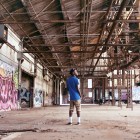A House of Art Offering Inner-City Youth a Creative Out
|
Originally appeared in The Chicago Bureau
Miguel Rodriguez, director of the Graffiti Zone, sitting outside the program’s home/Photo by Samantha Caiola
In a two-story brick residence in Humboldt Park, three teen artists sit around a table discussing their plans for an original neighborhood mixtape. There’s a tripod and a can of spray paint on the table, as well as a pile of paperwork, including grant proposals. The walls are covered in painted portraits. When these three turn 18, they’ll have the opportunity to live in this house as part of Graffiti Zone’s Artist-in-Residence program, which pays young artists a weekly stipend to hone their passions and, they hope, beautify a neighborhood too often making headlines for its violence. The teens – currently ages 16 to 17 – were commissioned to the house by Miguel Rodriguez, who at 20 is the director of Graffiti Zone, a Chicago nonprofit that helps at-risk teens express their talents.
